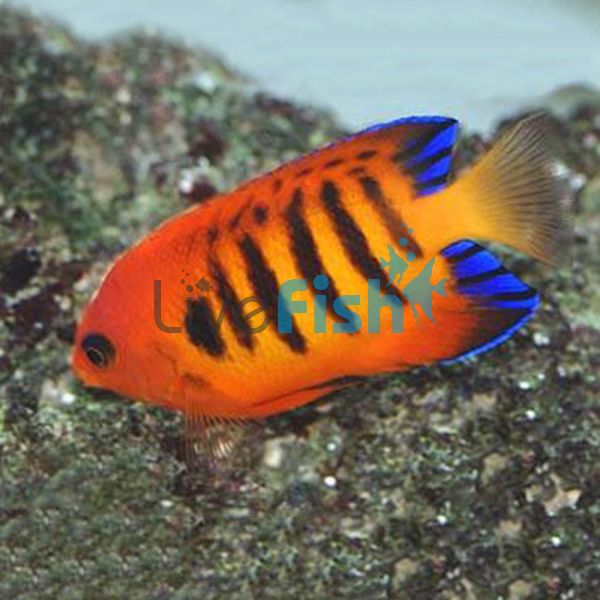Flame Angelfish - Medium
The Flame Angelfish is one of the most popular Dwarf Angelfish. It’s easy to see why this fish is so popular with it’s rich red to orange body with black vertical bars and the electric blue tipped dorsal and anal fins.
Flame Angelfish
The shape of the Flame Angelfish is that of a typical Dwarf Angelfish with an oval-shaped body with rounded fins.
The colouration of the individuals varies depending on where they originated from. Flame Angels from close to Hawaii are a deeper red colour than those originating from the Micronesia area.
The number and thickness of the black vertical bars can also vary a great deal. They can be thin or thick or sometimes run into each other and vary in number from between 3 and 7.
Male Flame Angelfish are usually larger than the female and generally, the blue on the dorsal and anal fins is more noticeable on the males.
All Flame Angelfish are born female and so you can pair them according to size. The larger fish becomes male, so making a pair is possible by buying a larger Flame Angel and a smaller Flame Angel. Then within a few months, they should assume their male and female roles.
In the wild, Flame Angelfish live in harems with a male and 3 to 7 females. They like to live close to stony coral growths in clear lagoon reef patches, reef faces, and outer reef slopes.
Flame Angelfish found over a wide area across the Western Pacific Ocean from Belau to the Hawaiian, Marquesas, and Ducie Islands, south to the Great Barrier Reef and the Pitcairn Islands
Tank Recommendations for Flame Angelfish
To keep a single Flame Angelfish the smallest tank size should be at least 114 litres (30 gallons). If you want to keep it with more fish then you should allow for at least a 284 litre (75 gallons) tank. If you are keeping a pair of them then you should provide a tank of at least 379 litres (100 gallons).
They do not get along with other dwarf angels unless the tank is well over 379 litres (100 gallons). The bigger the tank the better with lots of hiding places so they can keep out of each other's territories.
This is a shy fish and so does need plenty of places to hide so it will feel secure enough to come out. Live Rock is a good choice as you can ensure that there are plenty of cracks and crevices for them to hide between. Algae growth on the live rock will also provide a food source for the angelfish.
Be cautious with Flame Angelfish as they have been known to destroy corals, sponges, and other reef life.
Suitable Tank Buddies
You can keep these Angelfish with similar sized fish with a similar aggression level. Flame Angelfish are most aggressive towards newly added fish that are similar in shape or eating behaviour that will compete with them for food.
Like most Dwarf Angelfish it should be the last fish you introduce. It’s always best to keep them in larger tanks, where they should get along with other peaceful tank mates.
Usually Compatible
These fish usually mix well with Basslets, Cardinalfish, Butterflyfish, Clownfish, Gobies, Damselfish, Hogfish and Tangs to make lively and colourful reef tanks.
Sometime Compatible
In larger tanks, you can keep this dwarf angel with other dwarf angels without too much of a problem. If you have two male Flame Angels it's important that the tank is well over 379 litres as in smaller tanks they are likely to fight to the death. Be careful mixing them with Eels, Groupers, Scorpionfish and some Wrasses who may eat the Flame Angelfish.
Rarely Compatible
Sharks will see the Flame Angelfish as food and eat them. You also shouldn’t keep these fish with Seahorses or Pipefish as the Flame Angelfish is too aggressive and territorial. Keeping them with these slow swimming peaceful fish will prevent them from eating and cause them to eventually starve.
Feeding Your Flame Angelfish
Flame Angelfish are omnivores and generally good eaters. You can feed them a wide variety of foods and having live rock with algae growth on it for them to eat between meals.
They feed primarily on algae in the wild, but also consume small animals living amongst the algae. In the aquarium, they also mainly eat algae, so in addition to algae growing on the live rock, you can also feed them dead marine algae flakes and pellets. You can also feed them live food like brine and mysis shrimp.
You should feed your Flame Angels several times a day even if there are algae in the tank on live rock for them to eat. Feeding them small meals a number of times a day will help to reduce their aggression when guarding their territory and food resources.
| Scientific Name | Centropyge Loriculus |
|---|---|
| Care Level | Moderate |
| Common Names | Flame Angelfish, Flame Angel, Dwarf Flame Angelfish. |
| Diet | Omnivore |
| Fish Family | Pomacanthidae |
| Lifespan (years) | 6 |
| Max. Length (cm) | 10 |
| Min. Tank Volume (l) | 208 |
| Origin | Indo-Pacific |
| Reef Safe | With Caution |
| Sociability | Semi-aggressive |
| Venomous | No |
| Water Conditions | 22 - 27°C, dKH 8-12, pH 8.1-8.4, sg 1.020-1.025 |




